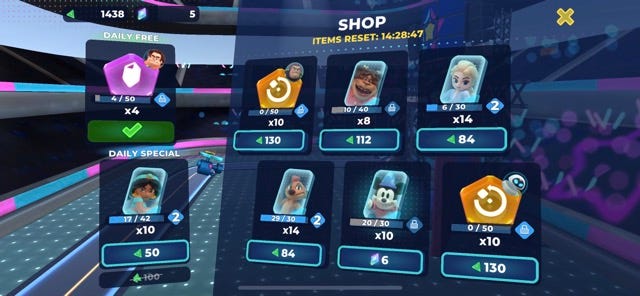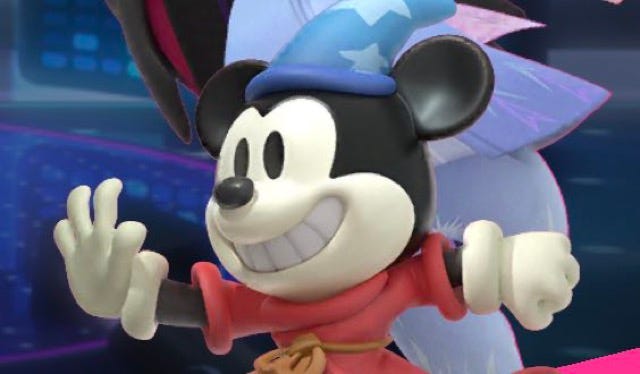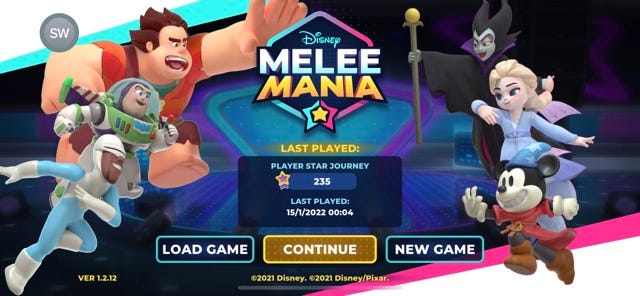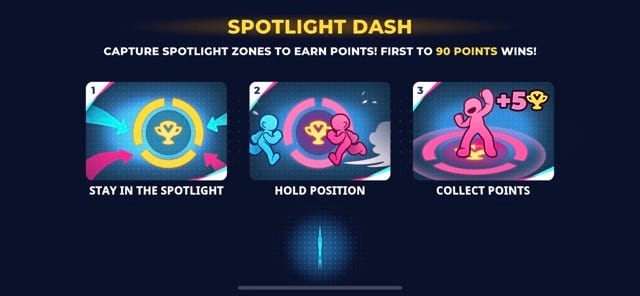Should You Play Disney Melee Mania?
Maybe try these free-to-play titles instead
Today’s post comes with a couple of caveats:
Disney Melee Mania is very clearly designed for kids (which I am not), as its resemblance to Disney Infinity makes it clear.
I tend to despise Free to Play games.
Disney Melee Mania is the most recent brand new release on Apple Arcade, a mobile brawler game for 6 players, split into two teams of 3v3. Games last 3 minutes, or however long it takes one team to score the requisite number of points. There are currently 12 characters available to play, with the promise of more to come down the line.
But should you play it?
The short answer is, I don’t think so. The longer answer? Well let’s chat.
Mobile MOBA Madness
But first, let's dig in a bit into what this game is all about. MOBA stands for Multiplayer Online Typically it's a 10 player game (5v5) where players battle against each other across a map. Each character has a set of attacks and special powers that distinguish them. Some characters exist to support the team while others exist to kill enemies. The fun of the game is about working together to outsmart the opponent. Instead of competing on an open field, players battle each other in lanes that contain towers (and sometimes other AI grunts). And unlike other fighting games, you win by knocking down your opponent's structures. So if you’re looking for something with a bit more strategy they can be a good fit.
What’s a Mobile MOBA?
MOBAs are not a new category, but the explosion of mobile MOBAs is relatively recent. I think it has to do with the increasing power of phones and the ability of touch screens and fast enough wifi to handle a multiplayer experience.
I have a decent amount of experience with PC MOBAs like League of Legends and Heroes of the Storm but much less with mobile games. So I picked up a couple of the more popular, recent ones Pokemon Unite and Brawl Stars. Pokemon Unite is a more traditional 5v5 MOBA-version of Pokemon (designed for Nintendo Switch but also released on mobile) and Brawl Stars is the game Melee Mania appears to be based on, a 3v3 king of the hill battler.
The two biggest differences that jumped out to me are the size of the screen and the lack of a controller. In a "full" MOBA on a computer you control a keyboard, a mouse, and a detached screen that allows a full range of articulation.
On mobile, your thumb spends a decent chunk of the game covering thescreen, and playing the game for too long just isn’t that fun. A "full" MOBA on a PC might last up to 40 minutes, a length of time that would be incredibly uncomfortable to maintain on a phone. So mobile maps are smaller, so you don't have to spend as much time traversing the game and can spend more time battling and completing objectives.
Where Melee Mania Fits
Disney Melee Mania is more of a "brawler" or "beat em up". Like a MOBA you're fighting on a team, controlling a hero with special powers. The brawler diverges from a MOBA in that instead of trying to complete an external objective, the focus is more directly on killing members of the other team. And unlike MOBAs the games tend to be shorter, in the 3-5 minute range instead of 10 minutes.
I chose Pokemon Unite because, like Melee Mania, it relies on recognizable characters and it’s aimed a younger audience than a game like League of Legends. Secondly, Pokemon Unite was roundly criticized for pay to win mechanics that made the game unfun. And Brawl Stars is the most similar game to Melee Mania of any I’ve seen. The goals of the game are slightly tweaked (it’s more complex and has more game modes), but playing through gave me a sense of what the design looks like.
The developers, Mighty Bear Games, also created the fun mobile “Fortnite-like”, Butter Royale. In an interview with IGN, they walk through wanting to create an approachable MOBA/brawler game that any member of the family could play. And the game manages to capture a lot of the tropes of the genre while simplifying the controls and the complexity many of the dominant games have.
If your goal is to find a mobile game with Disney characters, without an in-app purchases, and no social features to speak of, Disney Melee Mania is the game for you. Pokemon Unite features in-app purchases and Brawl Stars features both purchases and also social features like clubs and chat. Both are more complicated than Melee Mania.
At its heart, Melee Mania is a simplified version of a Moba/Battler. It doesn’t use a system of mana to trigger abilities, there’s only a simple cooldown that determines how often you can use a special. And there isn’t much complex strategy, the two game modes are either a strict “king of the hill” where you have to stand on top of a zone to collect points, or a bruising game where you try to kill your opponents more times than they kill you. This all seems in service of targeting younger players.
And there’s nothing wrong with building a simpler game. It’s just I don’t think the simplicity is in service of anything particularly fun. What stuck out to me playing through the three games is how the challenge of building a mobile Moba is creating a unique feeling character with roughly 4 square inches of screen real estate and 3 unique abilities. Doing so with beloved, recognizable characters is an additional level of difficulty.
But the Disney characters’ abilities felt the same across the board. There was the basic attack that would target a straight line (or sometimes a short sweep), a special ability that boosts speed, and an ultimate that deals a bunch of damage and sometimes freezes the enemy in place. Most games devolved into all members of the team running to the center, spamming their abilities, and then the remaining players of the losing team running away while the other players chased them down, rinse repeat. Heck, even Ralph (of Wreck-it Ralph fame) had a basic attack (his punch) deal ranged damage! The damning thing about the game was that the characters felt incredibly similar to one another, and un-representative of the character I remembered from the movie.
Not Freemium, Freemium
The two main arguments against freemium games is the concern about lootboxes and how they can obscure the fun of the game. The hope was that games built in subscription services could start by focusing on the fun and worry less about the engagement. But, the opposite seems to have happened.
One of the core arguments against freemium games is that they obscure the fun of the game underneath a bunch of economic bullshit that's there to get players to spend money. I can't tell you how many games I've found myself interested in only to spend 5 minutes getting a tutorial on what the different currencies in the game are and how I can best spend them to maximize my fun. But ultimately the staying power of a game depends on its ability to have a fun system in the first place.
And, all of the freemiumesque games on Apple Arcade still use engagement systems to prove their value. I counted at least 3 different locations I could collect gems from. A character screen, the home screen, and the current “event” screen. It seems unlikely that an actual free to play game would make you jump through this many hoops to upgrade a character because they want you to see these screens and to encourage you to upgrade. I’m still confused and uncertain about what the point of creating so many gem/card based systems in a “free” mobile game that doesn’t have any pay to win mechanisms. Are they supposed to encourage me to play more? I much preferred the engagement system that Cozy Grove uses where you have a few daily quests which reward you for playing every day, but there aren’t economies that you have to manage outside of that.

More broadly I’m confused why Apple seems to continue pushing these sorts of mobile engagement mechanics. I get that they want to create games that players want to play every day, but the cost benefit for the systems seems to be even worse than a freemium game would be. If I spent $5 a month to play a freemium game, I would get something tangible for that purchase, here I have to spend $5 a month to get access to the game, and I still have to go through the stupid clicks to get the right gems. I’m not even allowed to play all of the characters!
Freemium Problems Remain, But the Games Are Better
The primary concerns for freemium games is that they are fundamentally exploitative, create unfair situations where you can play to win, and that the ad-tracking is bad. The exploitation concerns haven’t gone away but it’s hard to feel exceptionally angry about the issues of freemium exploitation when sports gambling is exploding across the country and Matt Damon is encouraging you to be like a conquistador and buy some cryptocurrency.
That’s not to say there aren’t real concerns here, just that I think there’s a more nuanced conversation to be had about our relationship between risky assets and personal enjoyments than we’re having right now.
The privacy concern is real, but I’m pretty skeptical about Apple’s relationship to all of it. Their answer seems to be you can either pick the Freemium market that represents the majority of their “services revenue” (in app purchases) or… directly buy a game subscription from Apple. shrug.
Finally, with regards to pay to win, companies generally seem responsive to player feedback when mechanics feel too unfair. Last September, Pokemon patched the system that was causing a lot of the angst about pay to win.
The Fun of It All
But ultimately, in order to make such a service like Apple Arcade viable, the games have to be better. What surprised me most about both Brawl Stars and Pokemon Unite is how many unique ideas they brought to the table.
Brawl Stars is a spin on a king of the hill format. Your goal is to collect 10 gems and then hold them for 15+ seconds. But the gems only spawn in the middle of the field, so there’s natural tension (and challenge) to hold the center. Once a character loads up on gems they’ll want to stay back, making it easier for the other team to grab the center. And because your gems spill onto the field when you die, the end of the game feels incredibly tense. A single mistake could result in your opponents snatching victory from you.
Similarly, Pokemon Unite brings a number of interesting ideas to the traditional MOBA genre. Instead of dealing damage to “towers” to destroy them, you battle against wild Pokemon to collect Pokeballs, which you then deliver to your opponent’s goals to destroy them. It creates a lot of variation and fun moments through the game. Your time is split between trying to defend your goals, collect Pokeballs, and score goals on your opponent. The games are longer (close to the 10 minute mark), but I was struck how tense they felt across the board.
With freemium games, I still believe that single player experiences tend to lead to the types of frustrating, exploitative experiences I dislike. But with multiplayer games, I think the opposite is true. Because MOBAs want large player bases, freemium helps them expand to a wide audience, supporting players who love the game and want to pend money with opportunities to play more balanced games, and players who don’t want to spend money, a fun game they don’t have to spend money on. And there’s a large incentive to keep the game balanced and to have a stream of new characters and experiences.
In Conclusion
If competitive battle games are your thing, I’d say go for Pokemon Unite or Brawl Stars on the simpler end, and if you’re looking for something more complex, go for League of Legends Wild Rift. The engagement mechanisms still annoy me, but underneath there’s a lot of charm, novelty, and depth.






